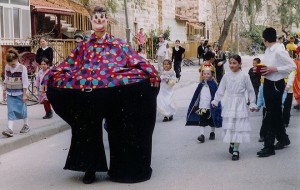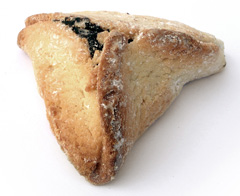WHAT IS PURIM AND WHEN DO WE CELEBRATE IT?

Purim is a joyous festival. It celebrates the story from the Book of Esther in which the Jews of Persia were saved by Queen Esther from destruction at the hands of the evil Haman. The name Purim comes from the Persian word ‘pur’ meaning ‘lot’ (as in ‘lottery’). It recalls that Haman cast lots to determine the day on which he would kill all the Jews.
We celebrate Purim on the 14th of Adar (which will fall in February or March).
HISTORICAL BACKGROUND
The story of Purim took place many years ago in the land of Persia. King Achashverosh married a beautiful Jewish woman by the name of Esther. Esther had an uncle, Mordechai, who had looked after her since the death of her parents. He advised her to conceal her Jewish identity from the King.
Haman, one of the King’s top advisors, was an evil and vain man who demanded that everyone bow down to him. When Mordechai would not bow down to him (being Jewish, he would only bow down to God), Haman became enraged and decided to kill Mordechai along with all the Jewish people.
To set the date on which he would carry out this plan, Haman cast lots (‘purim’). The date he determined was the 13th of Adar. Mordechai informed Esther of Haman’s plot and asked her to tell the king.
This was easier said than done, as it was the custom to approach the King only after being invited. This applied even to his wife. To ensure the mercy of God (and also presumably of Achashverosh), Esther asked all the Jews to fast for three days before she went uninvited to the King.
Meanwhile, Haman had erected a gallows on which he planned to hang Mordechai. When the King heard from Esther of Haman’s plan, he ordered that Haman be hanged there instead.
Achashverosh was reminded that years before, Mordechai had saved his life; to honour him, he made Mordechai his top advisor. Thus, instead of being killed on the 13th of Adar, Mordechai and the Jews of Persia were saved.
Mordechai sent letters rolled into scrolls to all the people in the kingdom, telling them what the King had done to Haman. The next day (14th Adar) was declared a holiday and thus ever since, Jews have celebrated Purim.
HOW DO WE CELEBRATE PURIM?

READING THE MEGILLAH (SCROLL OF ESTHER)
At synagogue, we listen to the story of Purim read from the Megillah (Megillat Esther). It is a mitzvah (commandment) to hear the story read in its entirety. Some people even bring their own Megillah scrolls so that they can fill in a word if they miss it in order to fulfil this mitzvah.
Children have noisemakers known as ‘raashanim’ (in Hebrew) or ‘greggers’ (in Yiddish) which they use to make noise to drown out the name of Haman whenever it is read. This noise and tumult adds to the joy and fun of the festival.
EATING A FESTIVE MEAL
It is customary to have a festive meal on the day of Purim. The meal is commence during the afternoon of Purim day. It is a mitzvah (good deed) to drink wine and be merry on Purim
MISHLOACH MANOT (SENDING FOOD PARCELS) AND MATONOT L’EVYONIM (GIFTS TO THE POOR)
It is customary on Purim to send gifts to one’s friends, often in festive baskets. Even school children traditionally exchange Mishloach Manot with their friends and prepare gifts to give or send to those less fortunate.
WEARING FANCY DRESS
Since a key theme of Purim is concealment and disguise (Esther hid her Jewishness from the King), dressing up in costume is a favourite Purim custom. In the Diaspora (outside Israel) it is mainly children who dress up, but in Israel and in religious communities, everyone does it. In Israel on Purim the streets are filled with characters from Biblical to TV superheroes and this helps to create the festive mood.
PURIM LITERATURE AND THE PURIM SPIEL
A Purim folklore developed over the generations and throughout the Diaspora. A special Purim literature developed which included humorous and satiric plays. Jewish newspapers usually carry a special satirical Purim supplement and in each community a ‘Purim Rabbi’ is appointed who pokes fun at local leaders, including the local rabbi.
PURIM GAMES
In order to increase the spirit of Purim, special games are played. The Talmud mentions an ancient game called Meshavarta de’Purim, in which wood and tar are burnt in the ground and children then dance around or jump over the bonfire.
 EATING PURIM FOODS
EATING PURIM FOODS
A number of foods are customarily eaten on Purim, many of them echoing the theme of concealment. There are hamantashen pastries containing various fillings, as well as foods to remind us of the special diet which Esther followed in the palace to avoid eating non-kosher foods. For more information about foods, please see our page Food on Purim.
SHUSHAN PURIM

Shushan Purim is the name given to the day 15th of Adar, the day immediately after Purim. It is an additional day on which Purim is celebrated, but only in cities which had a (protective) wall in the days of King David (Jerusalem is the main city in which Shushan Purim is observed today as it was already a walled city at the time of King David). The custom of observing Shushan Purim comes from the verse in Esther 9:18 which says that the Jews in Shushan (the capital city of Persia where the events of the Purim story took place) celebrated being saved from Haman’s decree on 15 Adar.



